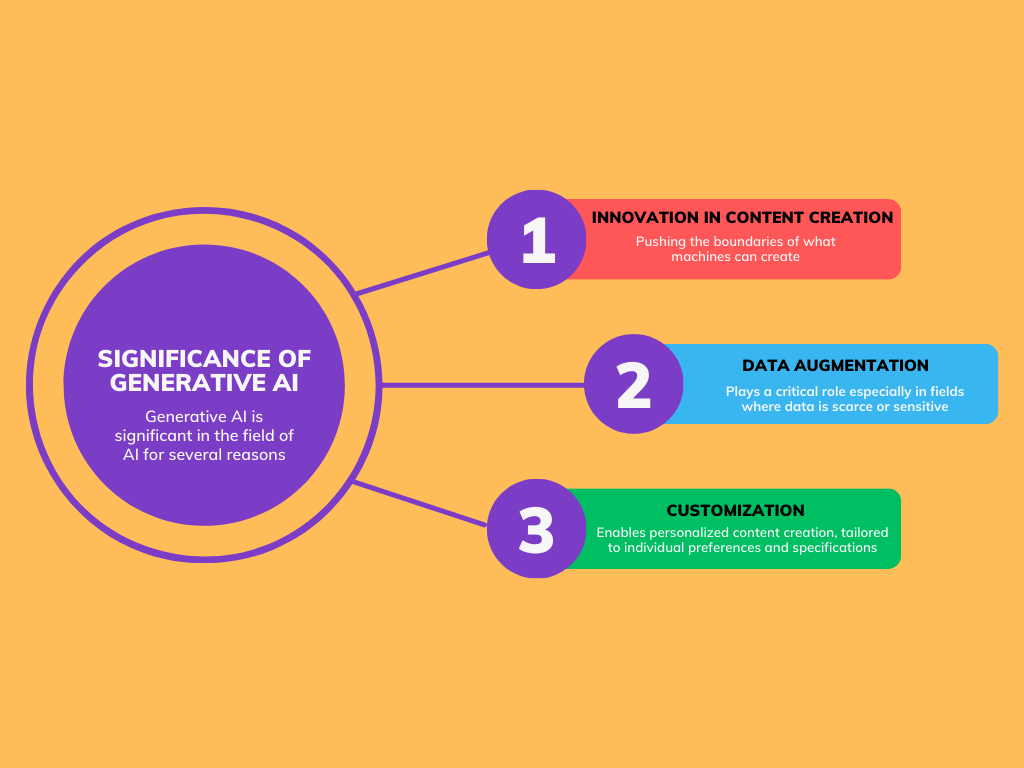What is Generative AI and its significance in AI?
Introduction
In the realm of Artificial Intelligence, Generative AI stands as a testament to how far we've come in our quest to endow machines with human-like creativity and intelligence. Unlike conventional AI, which interprets and analyzes data, Generative AI goes a step further – it creates. This capability is not just an academic curiosity; it's a revolutionary tool that's reshaping industries, from arts to engineering, and even the way we communicate.

What is Generative AI?
Generative AI refers to a subset of AI algorithms that can generate new content. This encompasses everything from synthesizing realistic images, composing music, creating written content, to generating realistic human voices. The principle behind Generative AI is to use existing data and learn from it to produce new, original content that's indistinguishable from human-created content.
The Significance of Generative AI
Generative AI in Natural Language Processing
Natural Language Processing, a branch of AI that focuses on the interaction between computers and human language, has been significantly transformed by Generative AI. Here’s how:
Text Generation
One of the most prominent applications of Generative AI in NLP is text generation. Advanced models like OpenAI's GPT-3 have demonstrated the ability to write essays, poetry, and even code, with a level of proficiency that's often indistinguishable from human output.
Language Translation
Generative models have also improved machine translation, enabling more accurate and context-aware translations. This advancement is crucial in breaking down language barriers in global communication.
Personalized Chatbots
With Generative AI, chatbots have become more sophisticated, capable of generating human-like responses. This has vast applications in customer service, mental health, and personal assistants.
Content Customization
Generative AI can tailor content to individual preferences, enhancing user experience in apps and websites. For instance, news aggregators can now generate summaries tailored to an individual's reading habits.
Challenges and Ethical Considerations
While Generative AI is a groundbreaking technology, it's not without its challenges and ethical dilemmas.
Quality and Coherence: Ensuring consistent quality and coherence in generated content remains a challenge.
Bias: AI models can perpetuate and amplify biases present in the training data.
Ethical Use: There's a growing concern over the misuse of technology, particularly in creating deepfakes or spreading misinformation.
Future of Generative AI
The future of Generative AI holds immense promise. We're likely to see more sophisticated models that can generate even more complex content. Additionally, as we refine these models, they will become more efficient, less resource-intensive, and more accessible to a broader range of users.
High-Level Insight on Generative AI and NLP
Generative AI’s role in NLP is a beacon of the potential of AI to not just understand human language but to actively participate in language-based tasks. The evolution of Generative AI models in NLP signifies a shift from rule-based systems to models that understand the nuances and complexities of language, thereby enabling more natural, human-like interactions between machines and humans.
Potential Developments
Looking ahead, we can anticipate:
More Advanced Conversational Agents: AI that can engage in meaningful, context-aware conversations, providing value in areas like education, healthcare, and customer service.
Enhanced Creative Writing: AI tools that assist authors and content creators in brainstorming, drafting, and editing, making the creative process more efficient.
Multilingual Models: Better support for a wide range of languages, especially those that are currently underrepresented in technology.
Conclusion
Generative AI is not just a technical achievement, it's a creative force that's redefining the limits of machine intelligence.


